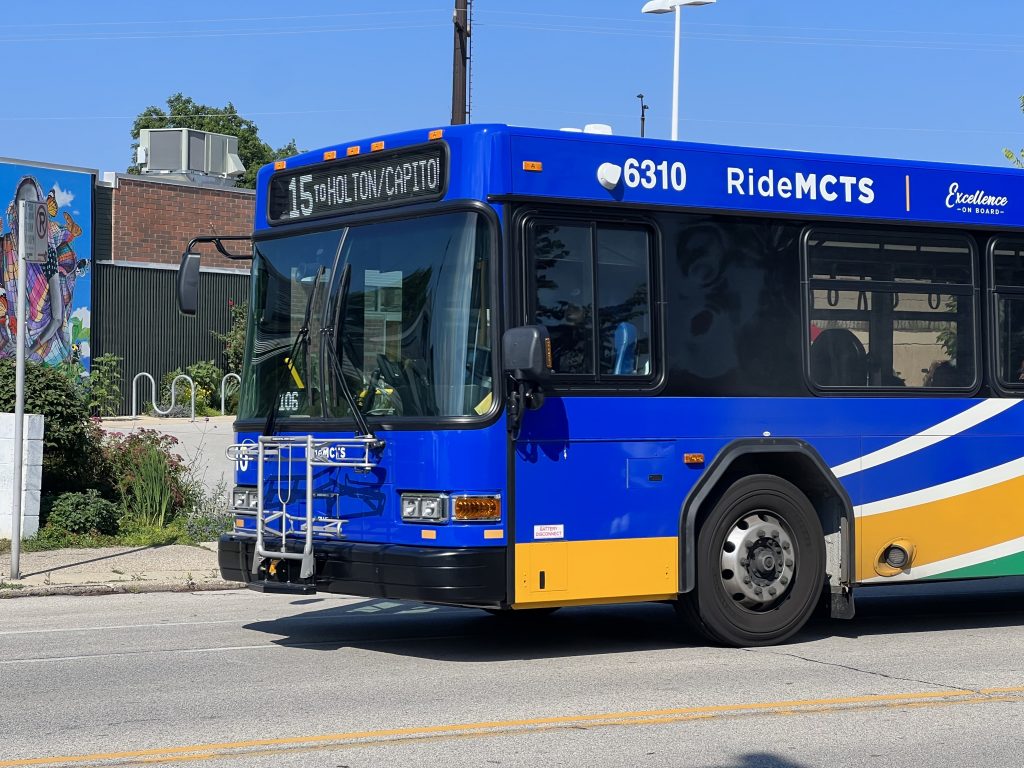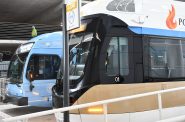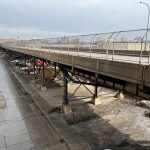MCTS to Make Major Changes, Cuts in Bus Service
How many of the system's 46 routes will have service hours or route altered?

MCTS bus. Photo by Jeramey Jannene.
The Milwaukee County Transit System has announced a raft of new service changes coming this fall.
Along with the returning school year and the route tweaks for this, MCTS is also implementing a series of new routes and adjustments it has been planning all year, as well as a number of cuts to service hours in response to the 2025 operating budget deficit. On Aug. 24, 40 of the system’s 46 routes will have service hours or route altered.
MCTS implements service changes four times a year, coinciding with quarterly changes to the bus operators’ schedules. The system was building up to the fall change all year, preparing to roll out MOVE 2025, a budget-neutral overhaul based on extensive data and feedback collected directly from passengers and drivers.
In June, however, MCTS caught everyone by surprise, including the labor union representing its workers, when it announced a projected $10.9 million budget deficit for 2025. Top county policymakers had not been informed and learned of the deficit when they read it in the news. At the same time, MCTS announced plans to cut bus frequency in the fall along a number of high-frequency routes. The frequency cuts, which translate to fewer service hour on the road, fall across 17 routes.
It’s likely these cuts are just the beginning. Top transit and transportation officials have recently said the system is too big for the current budget, and that service cuts in 2026 are not off the table. Federal stimulus funding will run out before 2027, which is sooner than expected, revealing a structural budget gap as big as $17 million.
MOVE 2025
The MOVE 2025 changes will take effect at the end of the month.
Bus frequency will be increased along Route 57, 63 and the BlueLine. Four new routes are also being created: Route 59 (Drexel Avenue), Route 73 (Mill Road), Route 74 (S. 43rd Street – Miller Park Way), and Route 82 (S. 13th Street – S. Howell Avenue).
Route extensions and modifications will occur along 14 routes including the BlueLine, RedLine and PurpleLine. For more details visit the MOVE 2025 website.
Fall High-Frequency Service Reductions
The service cuts will fall across 17 routes. A number of them previously met the bare-minimum high-frequency standard of one bus every 15 minutes. After the cuts, none will be high-frequency bus routes any longer. In 2021, MCTS implemented a major overhaul of the system, rebalancing it in favor of high-frequency routes.
Along all of the routes listed below the time between buses will increase by five to 13 minutes. The frequency reductions generally fall between the hours of 6 a.m. and 6 p.m. Some routes have been spared frequency reductions during high traffic times in the morning between 6 a.m. and 9 a.m. or in the evening between 3 p.m. and 6 p.m.
For more information on the frequency reductions, MCTS has posted a detailed list of the cuts.
- Route 12
- Route 15
- Route 18
- Route 19
- Route 21
- Route 22
- Route 24
- Route 35
- Route 51
- Route 57
- Route 60
- Route 66
- Route 76
- Route 80
- Route 92
- BlueLine: Riders North of W. Hampton Avenue will see a frequency increase.
- RedLine
Back-to-School Service Changes
MCTS has reconfigured the bus routes serving UW-Milwaukee to create a centralized pickup and drop off area near the university campus.
Beginning at the end of the month, all routes with turnaround points on the campus will arrive and depart along E. Kenwood Boulevard between Maryland and Downer Avenue. The U-Buses, which provide service beteween park-and- ride lots and local universities, will arrive and depart from Downer Avenue between E. Hampshire St. and E. Kenwood Boulevard.
For more details on the changes to service near UW-Milwaukee, see details provided by MCTS.
If you think stories like this are important, become a member of Urban Milwaukee and help support real, independent journalism. Plus you get some cool added benefits.
More about the 2025 MCTS Financial Issues
- FTA Tells Milwaukee to Crack Down on Fare Evasion — Even Where Fares Don’t Exist - Graham Kilmer - Dec 12th, 2025
- Transportation: County Names New Director of Transportation - Graham Kilmer - Dec 5th, 2025
- Transportation: MCTS Budget Picture Keeps Getting Worse - Graham Kilmer - Dec 4th, 2025
- Transportation: MCTS Avoids Full Route Cuts Under New Plan - Graham Kilmer - Nov 27th, 2025
- Transportation: Supervisor Pushes Fare Evasion Plan, Tangles With Sheriff - Graham Kilmer - Oct 23rd, 2025
- Transportation: Bus Cuts Leave Some Riders Stranded - Graham Kilmer - Oct 21st, 2025
- Transportation: Emails Reveal MCTS Officials Concealed Budget Deficit From Comptroller, County Board - Graham Kilmer - Oct 10th, 2025
- Transportation: 6 Bus Routes That Could Disappear in 2026 - Graham Kilmer - Sep 30th, 2025
- Transportation: MCTS Reaches New Labor Agreement With Union - Graham Kilmer - Sep 27th, 2025
- Transportation: Rep. Steil Calls For Greater Federal Oversight of MCTS - Graham Kilmer - Sep 17th, 2025
Read more about 2025 MCTS Financial Issues here
Transportation
-
Congestion Pricing Cuts Air Pollution in New York City
 Dec 14th, 2025 by Jeff Wood
Dec 14th, 2025 by Jeff Wood
-
FTA Tells Milwaukee to Crack Down on Fare Evasion — Even Where Fares Don’t Exist
 Dec 12th, 2025 by Graham Kilmer
Dec 12th, 2025 by Graham Kilmer
-
Will GOGO’s Bus Service Ever Get Going?
 Dec 9th, 2025 by Jeramey Jannene
Dec 9th, 2025 by Jeramey Jannene




















Shortening the #30 to Kenwood Blvd. seems like solely an operational move, not a customer focused move. Now residents of Sandburg Hall will have to walk the equivalent of 3 blocks for service. #30 service to the main entrance of the library is also lost. With the RED line being rerouted to Oakland, all service on Capitol Drive east of Oakland, and all service on Downer between Capitol and Kenwood is lost.
All the routes I take are on this list. I wonder if the fare evaders are as upset about this as am I.
But hey, MCTS now has an automated message reminding folks to pay their fare when they get on, not that it does any good. I saw 5 folks get on without paying yesterday.
As I stated before, nothing will improve until those in power start taking public transit and realize what a vital resource it is to the community, not just those dependent on public transit. Also, the pathetic excuse for a management company at MCTS needs to be replaced by a company that cares about public transit. I don’t think that will happen anytime soon, and the system will continue to deteriorate.
The same old types of cuts that happens every time the last cuts caused less ridership and lower revenue. The bus system will continue on a downward spiral, accelerated by these cuts because they make it less efficient.
MCTS has nearly the highest stops per mile of any transit system in the USA, and on average the USA has twice as many stops per mile as other countries. Half the stops could have been removed, saving money while making using the bus a MORE efficient option, increasing ridership, and getting it off the downward spiral. Time for a new approach, used just about everywhere else in the USA and the world.
I live along the route served by 15, 18, and Green, and have been complaining to MCTS for years about the empty buses running toward the end and beginning of service hours, often one empty bus immediately followed by another. Surely those middle of the night runs can be eliminated with little to no impact. I’ve also asked repeatedly for the S 1st and Pittsburgh SB stop be moved about a half block north where riders actually are versus the current location in the middle of a somewhat desolate, trash-strewn, vacant lot that feels unsafe after dark.
Also, I still feel that the elimination of some of the very popular “Freeway Flyer Park & Ride Shuttles” to major downtown events has added to traffic congestion and was a revenue loser. With parking downtown at premium prices, increasing car break-ins, & all the delays associated with driving, those shuttles never charged anywhere near what riders would be willing to pay for the convenience. It’s a sure moneymaker with added benefits and riders who actually pay!